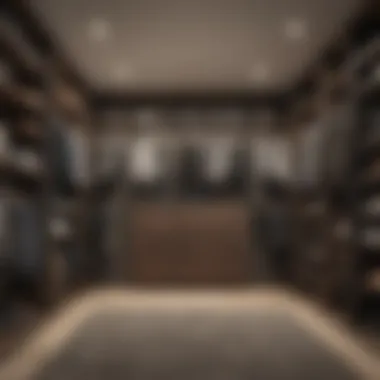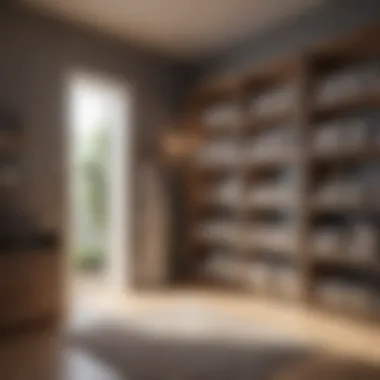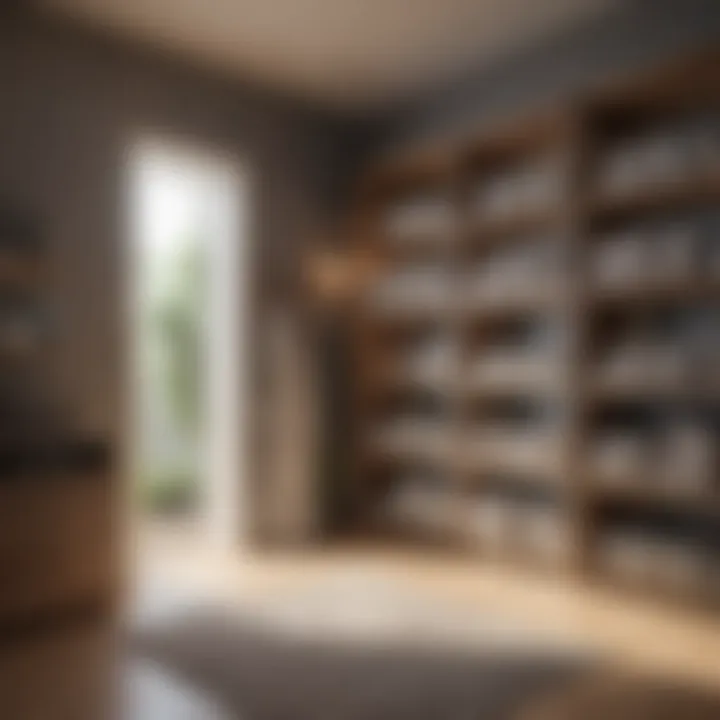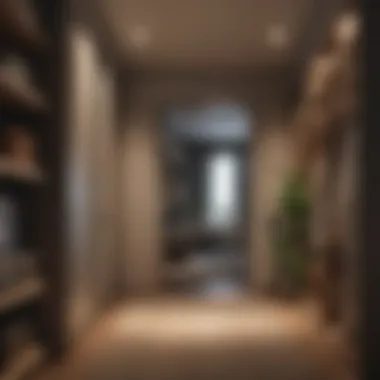Maximize Closet and Bedroom Storage with Style


Intro
Maximizing storage space in a closet and bedroom is essential for both functionality and style. As living areas become more compact, the need for efficient organization has greatly increased. This article explores a variety of strategies to elevate your storage solutions while maintaining a sense of aesthetics in your personal space. Furthermore, it emphasizes the significance of effective space management and how a well-organized environment contributes to overall wellbeing.
By examining innovative storage systems and techniques, readers will find practical advice that can easily be integrated into diverse living situations. Here, we aim to inspire homeowners, interior design enthusiasts, and anyone looking to create efficient, clutter-free environments.
Design Inspiration
Current Trends in Interior Design
Today’s design landscape suggests an inclination toward minimalism and functionality. A focus is placed on multi-purpose furniture that can adapt to various storage needs. For example, platforms beds with built-in drawers offer significant storage without taking additional space. Other concepts include open shelving systems, which visually expand the room while providing easy access to items.
Additionally, incorporating natural elements, such as wooden organizers or plants, can soften the space and enhance the overall atmosphere.
Color Schemes and Palette Ideas
When choosing color schemes for storage solutions, consider neutral tones that complement the overall decor. Shades like soft gray, beige, or muted pastels can create a calm environment. You can also add bold accents, such as navy blue or forest green, in smaller storage items to create visual interest.
Using cohesive colors across various storage solutions can also provide a sense of unity in the room. A well-planned color palette contributes to a cleaner look and can reduce the feeling of clutter.
Effective Organization Techniques
Categorize and Prioritize
Effective organization begins with categorizing items. Group similar items together, such as clothing types or accessories. This approach not only simplifies finding things but also makes it easier to see what you have.
Example Categories:
- Clothing (tops, bottoms, outerwear)
- Shoes
- Accessories (belts, bags, jewelry)
- Seasonal Items
Once items are categorized, prioritize what you use most often. Store these items in easily accessible places and keep less-used items out of the way. This strategy enhances functionality, allowing for quicker access to everyday essentials.
Utilize Vertical Space
When thinking of storage, it is important to not just consider floor space. Vertical space is often underutilized. Adding wall-mounted shelves or hooks can free up significant floor area. Maximize closet height by installing shelves or using stackable bins to keep items labeled and divided.
Sustainable Practices for Storage
Creating an organized space should also involve sustainability. Consider secondhand or eco-friendly storage options. Many stores offer products made from recycled materials. By choosing these items, you ensure you contribute to environmental conservation while maintaining stylish organization.
In summary, transforming your closet and bedroom into efficient storage spaces involves thoughtful design and organization. Emphasizing minimalism, utilizing colors wisely, and implementing smart storage techniques will create spaces that are both functional and aesthetically pleasing.
Understanding the Importance of Storage
Effective storage is essential in today’s fast-paced world. A well-organized environment not only enhances the visual appeal of a home but also significantly impacts its functionality. Proper storage solutions address the practical needs of homeowners while creating a sense of calm. This section explores the relevance and impact of storage on daily life, particularly in bedrooms and closets.
The Psychological Impact of Clutter
Clutter can have far-reaching effects on mental health. When items are strewn about, the mind often feels overwhelmed. Studies show that disorganization can lead to increased stress levels and even lower productivity. A chaotic space may create confusion, making it difficult to locate important items.
Conversely, a tidy environment fosters clarity. A well-organized closet or bedroom encourages a more positive mindset. When one knows where things are, it eliminates unnecessary mental clutter. For homeowners, maintaining order in these personal spaces contributes to emotional well-being. As a result, taking time to optimize storage can serve both functional and psychological purposes.
Benefits of a Well-Organized Space
A well-structured space brings a host of advantages. Not only does it simplify everyday tasks, but it also enhances quality of life. Here are some benefits to consider:
- Time savings: Finding items becomes quicker when everything has its place, allowing for a smoother daily routine.
- Increased space: Smart storage solutions maximize available space, making even small areas feel larger and more open.
- Enhanced aesthetics: An organized closet or bedroom looks visually appealing, creating a pleasing atmosphere.
- Improved focus: Less visual distraction helps improve concentration and productivity.
- Easier maintenance: Keeping a space tidy becomes easier when there is a clear organization system in place.
In summary, tackling storage is not merely about aesthetics. It involves understanding the deeper implications for mental well-being and efficiency in daily life. By recognizing these elements, homeowners can take actionable steps toward creating a more organized environment.
Evaluating Your Space
Evaluating the space in your closet and bedroom is a critical step in maximizing storage efficiency. Understanding your space allows you to identify opportunities and challenges for storage solutions. It lays the groundwork for effective organization and ensures that every inch is used wisely. Without this evaluation, even the most stylish storage solutions may not function properly. This section delves into the two main components of space evaluation: assessing room dimensions and identifying storage needs.
Assessing Room Dimensions
Knowing the dimensions of your room is the first step to successful storage optimization. It involves measuring the width, length, and height of your closet and available areas in your bedroom. This information is crucial because it helps you determine what type of furniture or storage systems will fit. For effective assessment:


- Use a tape measure: Ensure that you have accurate measurements for every wall.
- Create a floor plan: Draw a simple layout of the room with dimensions. This can help visualize the arrangement of furniture and storage options.
- Consider the flow: Think about how you move through the space. A well-measured area allows for easy access to items without clutter.
"A well-planned room maximizes efficiency and adds comfort."
Ultimately, assessing room dimensions is not just about fitting items; it is about creating a harmonious environment conducive to your lifestyle.
Identifying Storage Needs
After assessing the dimensions of your space, the next step is identifying your specific storage needs. This process involves taking stock of your belongings and understanding what you use frequently and what can be stored away. Here are some pointers to help with this process:
- Inventory Your Belongings: List out items like clothing, shoes, accessories, and linens. This inventory will highlight what you have, and it aids in sorting out what you truly need.
- Categorize Items: Group similar items together. For example, separate seasonal clothes, everyday wear, and accessories. This can guide where items should be stored inside the closet.
- Assess Usage Frequency: Identify what you access often. Frequently used items should be easily reachable, while seldom-used items can be stored in more remote locations.
- Consider Future Needs: Think ahead about any lifestyle changes. If you plan to acquire additional items, factor those into your storage planning.
By clearly identifying storage needs, you can tailor solutions specific to your lifestyle, minimize clutter, and improve accessibility within your closet and bedroom.
Types of Storage Solutions
The way we approach storage influences the overall feel of our bedrooms and closets. Exploring different types of storage solutions is crucial for maximizing both efficiency and style. Each solution has its distinctive benefits and considerations, making it vital to understand how they fit into individual needs. By selecting the right types of storage, homeowners can transform cluttered spaces into organized havens.
Built-in Closet Systems
Built-in closet systems are excellent for optimizing space. They offer a tailored solution, maximizing every inch of available area. Such systems often include shelves, drawers, and hanging spaces designed specifically for the user’s belongings.
Benefits include:
- Customizability: You can design these systems to fit your room. This ensures that the solutions work well with the room's dimensions.
- Increased Home Value: Adding built-in systems can enhance the overall aesthetic and functional value of your home, appealing to potential buyers.
- Enhanced Organization: Structured systems help categorize items, leading to easier accessibility.
When considering built-in systems, think about the following:
- Assess the layout of your room. A well-thought-out design will optimize positive flow.
- Select materials that complement existing decor. This maintains harmony in design.
Freestanding Furniture for Storage
Freestanding furniture is a flexible and versatile storage option. Items like dressers, shelving units, or cabinets can be placed anywhere in the room.
Some important advantages include:
- Mobility: These pieces can be easily moved to adapt to changes in your space or furnishings.
- Variety: The market offers a diverse range of styles, allowing for personalization.
- Affordability: Often less expensive than built-in options, making them accessible for more homeowners.
While freestanding options provide advantages, consider:
- The style should match the overall design of your bedroom.
- Ensure functionality fits your storage needs.
Under-Bed Storage Options
Using the space under the bed is an intelligent way to enhance storage without occupying additional space. Under-bed storage options such as bins and drawers provide a practical solution for storing seasonal items or less frequently used belongings.
Key reasons to use under-bed solutions include:
- Space Efficiency: This area often goes unused—the perfect opportunity to maximize storage.
- Accessibility: Items stored here can be easily retrieved without moving other furniture.
- Variety of Designs: There are numerous options, from sliding drawers to clear bins, allowing for individual preferences.
It’s essential to consider:
- Choose containers that fit the height of your bed.
- Ensure items are well-organized for easy retrieval.
Vertical Storage Solutions
Vertical storage solutions capitalize on often-overlooked wall space. Tall bookshelves, wall-mounted shelves, and hanging organizers provide ways to use the vertical area for storage effectively.
Benefits of vertical storage:
- Maximized Floor Space: This approach leaves more floor area clear, contributing to a more open feel in the room.
- Draws Eyes Upward: It creates an illusion of height, making smaller rooms feel larger.
- Improved Organization: Items like books, decor, and accessories are more visible and easy to access when stored vertically.
When implementing vertical storage:
- Ensure that structures are securely mounted to prevent accidents.
- Select shelves that blend well with existing decor.
"The right storage solution helps reveal the potential hidden within your space."


Explore more about effective storage solutions on Wikipedia, Britannica, or join discussions on Reddit.
Choose wisely and transform your living space.
Organization Techniques
In the journey of maximizing closet and bedroom storage, effective organization techniques play a pivotal role. Their benefits extend beyond mere aesthetics; organization directly influences efficiency and usability. When items are systematically arranged, it reduces the time spent searching, enhances the functionality of space, and promotes a sense of calm within the environment. Furthermore, a well-organized area often reflects the personality and habits of its owner, contributing to a more satisfying living experience.
Categorization of Items
Categorizing items is the foundation of effective organization. This process involves examining every item in your closet and bedroom, then grouping them based on type, usage, or even color. For example, clothing can be divided into sections such as everyday wear, special occasions, and seasonal pieces. By allocating space according to categories, you ensure that similar items are easily accessible. This method not only saves time but also helps in identifying which items are essential and which can be donated or discarded. A clear categorization system allows for more efficient management of your belongings, ensuring that everything has its designated place.
Labeling for Easy Access
Labeling is an essential technique to enhance accessibility in any storage system. When labels are used, items become straightforward to find, which drastically reduces frustration. Consider utilizing clear labels for bins, drawers, and shelves. You might opt for a simple label maker, or handwritten tags can also add a personalized touch. Ensure that the labels reflect the contents accurately. For instance, if a box holds winter clothing, a label should read "Winter Wear". This small step can be remarkably valuable in maintaining order and efficiency.
Rotation of Seasonal Items
Seasonal rotation is a practical approach to managing closet space effectively. Many people own clothes, shoes, or gear that are only relevant during specific times of the year. By rotating these items, you keep only what you need at hand while storing away the rest. This not only frees up valuable storage space but also keeps your closet appearing organized. Each changing season should prompt a review of your storage setup. For instance, summer clothes can be packed away in bins or under-bed storage during winter months, allowing for a streamlined selection of usable items at any given time.
"An organized space is not just a reflection of a tidy life but a pathway to efficiency and serenity."
Implementing these techniques will cultivate a more efficient organization system in your closet and bedroom. By categorizing, labeling, and rotating seasonal items, you are not just optimizing space; you are enhancing your overall lifestyle.
Design Considerations
Design considerations play a crucial role in maximizing closet and bedroom storage. They encompass not only the space available but also the functionality and aesthetic appeal of the solutions chosen. When designing a storage system, one must weigh how items will be accessed, the type of materials used, and the overall design scheme of the room. This consideration ensures that storage enhances rather than detracts from the enivornment.
Aesthetics and Functionality
The dual focus on aesthetics and functionality is essential. A storage solution must be pleasing to the eye while serving its practical purpose. For instance, open shelving can create an airy feel, but it may require more effort to keep tidy. Meanwhile, closed cabinetry hides clutter but can seem bulky if not designed well.
Incorporating smart design elements such as pull-out drawers or lazy Susans can optimize space utilization. These features not only add a modern touch but also make it easier to access items, thereby reducing frustration. When selecting elements, the balance between form and function must be deliberately considered.
Incorporating Color and Materials
The choice of color and materials adds depth to storage design. Using lighter tones can create an illusion of spaciousness, while darker colors can add warmth and elegance. When incorporating color, think about the overall color scheme of the room. Neutral colors often blend well with various decor styles, offering flexibility.
Material selection is also vital. Choices like bamboo, reclaimed wood, or metal not only provide durability but can also reflect personal style. Bamboo, for example, is an eco-friendly option that adds a natural earthy vibe to any space.
In summary, design considerations combine utility with visual appeal. A well-thought-out design approach ensures that storage is not just an afterthought but an integral part of the room’s aesthetic and functionality.
Sustainable Storage Practices
In modern interior design and organization, sustainability plays an essential role. This is not just a trend; it is a perspective that emphasizes the long-term benefits of eco-friendly storage practices. Recognizing the impact of waste on the environment has pushed many homeowners towards more responsible choices. Sustainable storage practices can enhance both functionality and style, all while supporting environmental conservation.
Using sustainable methods ensures that materials are responsibly sourced and have minimal negative effects on the surroundings. This can lead to a healthier home environment. Additionally, adopting these practices may help in reducing clutter. By carefully selecting storage options, one can create spaces that not only look good but also align with personal values.
Choosing Eco-Friendly Materials
When designing or updating storage solutions, the choice of materials is crucial. Eco-friendly materials can include bamboo, reclaimed wood, and recycled metals. These options often reduce the carbon footprint associated with traditional materials. For instance, bamboo is rapidly renewable and provides a sturdy yet stylish alternative for furniture and shelving.
Moreover, using materials like recycled wood helps avoid deforestation. It looks distinctive as it often retains character with natural variations. This promotes a unique aesthetic while contributing to environmental sustainability. Another option could be using storage containers made from recycled plastics. These are durable and available in various styles, ensuring functionality and flair.
- Consider local sourcing: By purchasing from local artisans or suppliers, you reduce transportation emissions.
- Look for certifications: Reputable credentials like FSC (Forest Stewardship Council) indicate responsibly sourced woods.
- Prioritize durability: Items that last longer reduce the need for replacements, contributing to waste reduction.
Minimalism as a Storage Solution
Minimalism is more than a design trend; it is a lifestyle choice focused on simplicity and intentionality. By embracing minimalism, one can reduce excess items and thereby simplify storage needs. Having fewer items can make organizing spaces less overwhelming. It promotes a cleaner, more orderly environment.
In a minimalist setting, storage solutions are often integrated seamlessly into the decor. This creates a cohesive look that avoids visual clutter. One effective approach is to use multi-functional furniture. For example, ottomans with hidden storage compartments can serve dual purposes. They provide seating and offer space for blankets, books, or other items.
Additionally, adopting a minimalist mindset encourages regular review of belongings. Periodic decluttering helps identify what is truly needed. This not only reduces stress but also ensures that the items kept are valuable and used regularly.
"Sustainability and minimalism, when combined, create spaces that serve their purpose well while respecting the planet."
Maintaining Your Storage System


When it comes to maximizing closet and bedroom storage, maintaining an efficient system becomes paramount. A storage system is not just about creating order; it is about sustaining that order to ensure continued functionality and accessibility. Regular maintenance prevents clutter from re-emerging, which can erode the benefits gained from an initial organization push. By focusing on routine decluttering techniques and assessing storage efficiency, homeowners can establish a vibrant atmosphere that reflects both style and utility.
Routine Decluttering Techniques
Decluttering is not a one-time event; it is an ongoing process that can significantly enhance your storage system. Implementing routine decluttering techniques helps keep your space in good order. Consider these practical steps:
- Set Regular Intervals: Plan periodic decluttering sessions, perhaps monthly. Align these with changing seasons to sort out items that may no longer fit.
- Adopt the One-Year Rule: If you haven't used an item in the past year, it may be time to let it go. This guideline encourages critical evaluation of sentimental and excess belongings.
- Create Drop Zones: Establish designated areas for items you are unsure about. This allows a few days for reflection, while avoiding impulsively discarding essentials.
- Use a Sorting System: For each item, sort into categories: keep, donate, or discard. Letting go ofunwanted items fosters a more efficient living space.
These techniques not only foster cleanliness, but also aid in reshaping your perception of materials you own. A systematic approach lends itself to clear decision-making and diminishes the stress associated with clutter.
Assessing Storage Efficiency
After initial organization, the next step is to assess the efficiency of your current storage system. This evaluation focuses on whether the storage solutions in place enhance the functionality of your space. Here’s how to methodically assess your storage:
- Inventory Check: Maintain a thorough record of items stored. It's crucial to know what you have to avoid repurchasing unnecessary duplicates.
- Evaluate Accessibility: Ensure that frequently used items are easily accessible. If you must move several items just to reach something, your current setup may need rethinking.
- Space Utilization: How efficiently is the space being used? Look for areas that can serve dual purposes or consider vertical storage options to maximize underutilized areas.
- Feedback Loop: Ask household members for their opinions on storage efficiency. They may have insights that highlight areas needing improvement.
Assessing storage efficiency is an ongoing exercise that not only supports a cleaner space but also contributes to a more enjoyable and functional living environment. Effective maintenance habits form the backbone of a well-organized closet and bedroom.
Remember, a well-maintained space transcends tidiness; it cultivates a sense of calm and order in homeowners' lives.
By implementing these strategies, you can ensure that your storage system remains a source of pride and utility, continuously adapting to your needs.
Inspiration and Case Studies
Understanding the inspiration and case studies related to closet and bedroom storage is essential for homeowners and interior design enthusiasts. This section provides tangible examples of what can be achieved within personal spaces. It offers readers new perspectives and practical ideas for effective space utilization, enhancing both the aesthetic and functional aspects of their homes. Through real-life transitions and expert creative ideas, individuals can see how systematic changes can lead to significant improvements in organization and style.
Real-Life Transitions
Real-life transitions highlight the journey individuals take to transform their cluttered spaces into organized havens. Examining specific instances provides insights into challenges faced and solutions implemented. These case studies showcase various scenarios, from small apartments to larger homes, illustrating how even modest adjustments can lead to impactful changes.
For instance, a homeowner might start with disorganized closet space overflowing with clothes and seasonal items. Through a phased approach, they could first assess their clothing needs, then categorize items into essentials, seasonal gear, and items to donate. After implementing vertical storage and under-bed solutions, the result is a tidy space that promotes daily efficiency and a sense of calm.
"Seeing practical applications in real life is inspiring. It encourages us to envision our own potential transformations within spaces we live in."
Each case study reflects the process of decluttering, restructuring, and reorganizing. By observing various methods, readers gain practical ideas while also becoming aware of the emotional satisfaction that comes from a well-organized space.
Creative Ideas from Experts
Expert perspectives provide invaluable insights into various creative solutions for storage challenges. These professionals not only suggest functional approaches but also emphasize the importance of aesthetic appeal. Creative ideas often merge innovation with style, allowing individuals to express personal taste while optimizing storage.
For example, interior designers may recommend using multi-functional furniture. A stylish coffee table with hidden compartments can act as a central decorative piece while also providing a place to store magazines or blankets. Another expert might suggest custom-built shelves that align with the room’s design. Choosing open shelving allows for organization while displaying items that reflect the homeowner’s personality.
Furthermore, incorporating decor elements with functional storage can bridge the gap between style and efficiency. For instance, using decorative baskets or elegant bins for storing lesser-used items not only keeps spaces neat but also adds a layer of design interest.
Here are some expert tips on enhancing storage creatively:
- Use mirrors to create an illusion of space.
- Install hooks for easy access to items like bags or accessories.
- Invest in stackable containers that maximize vertical space.
- Choose collapsible options for seasonal use to minimize clutter.
Each expert insight speaks to the balance between function and aesthetic, empowering homeowners to create beautiful, organized living spaces. By drawing from inspiration and real-world applications, individuals can confidently approach their own storage challenges with creativity and purpose.
The End
In an era where space is often at a premium, maximizing closet and bedroom storage is not just advantageous—it is essential. The insights offered in this article reiterate the importance of effective space management to create an environment that is both functional and aesthetically pleasing. By understanding the unique needs of your space and integrating innovative storage solutions, one can dramatically improve organization and accessibility.
The benefits extend beyond mere tidiness. A well-organized bedroom contributes to a more serene atmosphere, impacting mental well-being. When clutter is minimized, one's ability to focus and relax enhances. This is particularly relevant in today's fast-paced world where personal sanctuaries, like bedrooms, can greatly influence overall quality of life.
As we move toward sustainable living practices, the conclusions drawn here align with eco-friendly choices that not only serve personal needs but also consider the environmental impact.
Key aspects emphasized in this article include:
- The psychological benefits derived from a clutter-free environment.
- Diverse storage solutions tailored to individual requirements.
- Techniques for maintaining organization and ensuring longevity of systems implemented.
"Effective storage management is more than just about space; it is about creating an environment that promotes well-being."
Recap of Key Points
- Understanding the Importance of Storage: Recognizing the psychological impact of clutter and the benefits of organization.
- Evaluating Your Space: Assessing room dimensions and identifying specific storage needs.
- Types of Storage Solutions: Exploring both built-in and freestanding options, including under-bed and vertical solutions.
- Organization Techniques: Implementing categorization, labeling, and seasonal rotation of items.
- Design Considerations: Balancing aesthetics with functionality through thoughtful use of color and materials.
- Sustainable Storage Practices: Choosing eco-friendly materials and adopting minimalism as a way to reduce clutter.
- Maintaining Your Storage System: Employing routine decluttering techniques and assessing efficiency regularly.
- Inspiration and Case Studies: Learning from real-life transitions and expert insights.
Final Thoughts on Closet and Bedroom Storage
Effective storage in closets and bedrooms is an ongoing process. It’s necessary to regularly assess both physical items and the systems used for organization. Trends in design and materials may change, but the core principle remains the same: an efficient space can lead to a more satisfying daily life.
By implementing the strategies discussed, homeowners and design enthusiasts can cultivate spaces that are not only practical but also resonate with personal style. The journey toward achieving an organized bedroom begins with a single step—recognizing the value of how space should be utilized.
Through thoughtful organization, individuals can transform their surroundings, sustaining a calm and inviting space conducive to relaxation and rejuvenation.



